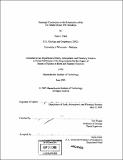Structural constraints on the exhumation of the Tso Morari Dome, NW Himalaya
Author(s)
Clark, Ryan J
DownloadFull printable version (14.99Mb)
Other Contributors
Massachusetts Institute of Technology. Dept. of Earth, Atmospheric, and Planetary Sciences.
Advisor
Kip Hodges.
Terms of use
Metadata
Show full item recordAbstract
The Tso Morari culmination in the Ladakh region of northwest India is a large (>3,000 km²) structural dome cored by coesite-bearing rocks of Indian continental crustal affinity. As one of only two localities in the Himalaya where ultrahigh-pressure rocks have been found, the culmination offers important insights into the orogenic processes responsible for exhumation of subducted continental crust. New, 1:50,000 scale geologic mapping and structural analysis in the Tso Morari area reveals evidence for five distinct deformational events. Rather than simple, one step processes envisioned by investigators in many ultrahigh-pressure terrains, exhumation of the Tso Morari culmination was a polyphase process. From >90 km to mid-crustal depths, exhumation was accommodated by a diachronous set of rooted, ductile, extensional detachments that were active [approx.] 53-40 Ma. Beginning in the Late Oligocene, continued exhumation occurred by progressive unroofing along a younger, brittle-ductile detachment. Through a rolling-hinge mechanism similar to that proposed for many metamorphic core complexes of the North American Cordillera, this unroofing led to the development of the culmination into a NW trending structural dome. (cont.) More recently, N-S-striking normal faults accommodated continued upper crustal extension throughout much of the remainder of Cenozoic time, despite the culmination's setting in the Himalayan collisional orogen.
Description
Thesis (S.M.)--Massachusetts Institute of Technology, Dept. of Earth, Atmospheric, and Planetary Sciences, 2005. Includes bibliographical references (p. 35-38).
Date issued
2005Department
Massachusetts Institute of Technology. Department of Earth, Atmospheric, and Planetary SciencesPublisher
Massachusetts Institute of Technology
Keywords
Earth, Atmospheric, and Planetary Sciences.